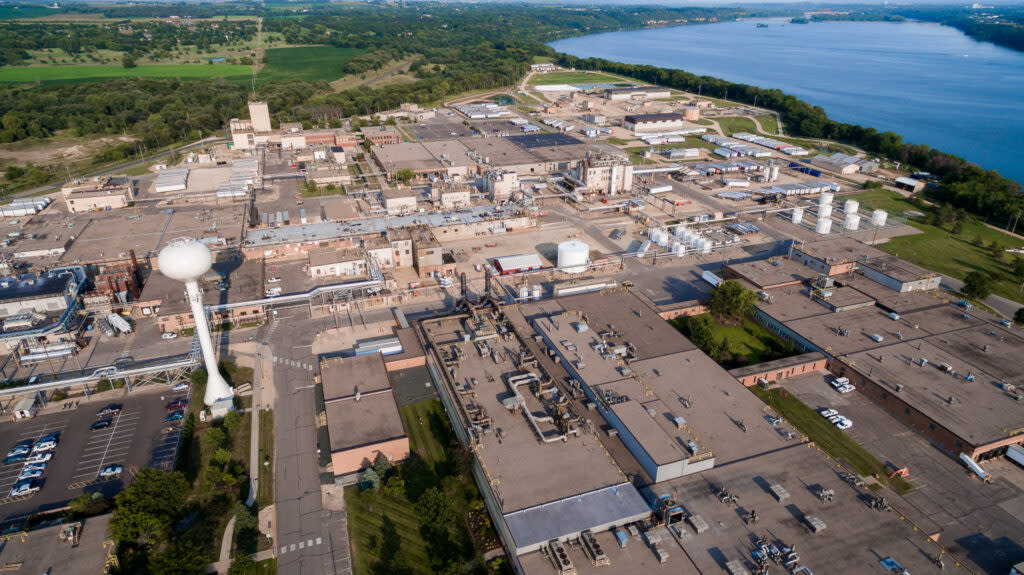Minnesota proposes water pollution permit for 3M plant that makes forever chemicals

3M still manufactures PFAS at this plant in Cottage Grove. Photo by Chad Davis.
The 3M Cottage Grove chemical plant that contaminated 200 square miles of east metro drinking water has been operating on a water pollution permit that expired more than 20 years ago.
But now the Minnesota Pollution Control Agency has issued an over 400-page draft of a new wastewater permit for the plant, which the agency says is one of the most rigorous in state history. It requires that per and poly-fluoroalkyl substances — known as PFAS — be removed to the point they cannot be detected, through an advanced treatment system 3M is building.
3M says it’s on track to invest nearly $300 million in advanced water treatment systems at its Cottage Grove facility. The system, on which construction began in 2021, is engineered to remove a range of PFAS from water as part of a long-running cleanup program.
3M says the technology will continue to remediate PFAS in area groundwater even after the company exits the PFAS market by the end of 2025.
One catalyst for the rigorous new permit is the U.S. Environmental Protection Agency’s new drinking water regulations banning even trace amounts of the chemicals.
The draft permit would require 3M to limit pollutants in wastewater and stormwater, protecting the Mississippi River and improving accountability, the MPCA says.
It’s the state’s first industrial wastewater permit to limit PFAS.
The Cottage Grove plant is the epicenter of PFAS pollution in Minnesota and beyond. Since the 1950s, 3M has made the toxic chemical compounds that repel water and oil and remain stable under nearly all conditions, earning them the nickname forever chemicals. The chemicals have been linked to a range of human health problems.
The Cottage Grove plant produces chemicals used in Post-it notes, Scotch Magic tape, catalytic converters, reflective road signs and license plates, golf club finishes and TV, laptop and cell phone screens.
As the chemicals’ toxicity became more widely known, the company has been the target of numerous lawsuits: Last year, 3M negotiated a $10.3 billion settlement over contaminated U.S. drinking water systems.
The MPCA issued a draft permit in 2011, but never finalized it after the state sued 3M in 2010, alleging the company failed for decades to report that its chemicals could be toxic to humans, animals and the environment and kept information from regulators and scientists to protect a lucrative revenue stream.
3M’s Cottage Grove plant discharges treated wastewater and stormwater into a creek that joins the Mississippi River at a rate that can exceed 15 million gallons daily, according to the MPCA.
Even without the new permit, 3M has been operating under a many-tentacled regulatory regime, including the old 2003 federal permit; a 2007 settlement agreement and consent order between 3M and the MPCA; the state’s 2018 settlement of a lawsuit against 3M over its contamination of east metro drinking water; and enforcement actions stemming from an ongoing investigation. For example, PFOS discharges have been limited since January 2021 due to an enforcement action.
A 3M study of the Mississippi River — released last year — also contributed to the draft permit. 3M found the fish in the Mississippi River from St. Paul to Hastings carried 16 types of PFAS. That prompted state health officials to advise that certain people avoid eating fish caught in the area.
“Forever chemicals have no place in any lake or river. The MPCA is committed to using all our authorities toward this end,” MPCA Commissioner Katrina Kessler said in a press release. “This permit is an opportunity to leverage the latest science, technology, and regulations on PFAS to require 3M do even more to keep PFAS out of the Mississippi River.”
Carly Griffith, water program director for the Minnesota Center for Environmental Advocacy, said the draft permit sets an important precedent for broader PFAS pollution controls in wastewater permits statewide.
Griffith said 3M also pumps over a million gallons of contaminated water per day from Woodbury to the Cottage Grove plant, where it’s treated and discharged into the Mississippi River.
The draft permit also requires 3M to expand its contamination monitoring efforts in groundwater, the Mississippi River and aquatic life, MPCA said.
3M said it plans to submit feedback to the agency during the 45-day public comment period now underway.
The post Minnesota proposes water pollution permit for 3M plant that makes forever chemicals appeared first on Minnesota Reformer.

